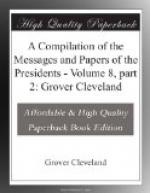Mars Hill would then have appeared to be in truth as well as in claim the northwest angle of the Province of Nova Scotia; and although the rest of the line would not have fulfilled the conditions, the United States might by an arbitrator have been compelled to accept this point as the beginning of their boundary. Nor, in the unexplored state of the country, is it by any means certain that the American agent, who does not seem to have seen the drift of the proceedings of Colonel Bouchette, would have been prepared with the adverse facts, which are now known to be undeniable. It may therefore be considered fortunate for the claim of the United States that the survey was afterwards intrusted to a surveyor who, in pursuit of the double object of encroachment on the United States and the enlargement of his native Province at the expense of Canada, signally failed in the proof of either of his positions.
The knowledge now acquired shows that the idea of Colonel Bouchette is unsupported by the facts of the case, for the highlands which rise from the north shore of the Bay of Chaleurs do not meet those in which the most southerly branch of the Restigouche takes its rise.
The British commissioners, although they give a profile of this ridge, do not pretend to have examined it except at Mars Hill, near the Aroostook, and at the Grand Falls of the St. John. It must be remarked that these profiles (the original one of Colonel Bouchette and that exhibited by themselves) are contrasted—one British authority with another—for the purpose of invalidating the ground on which the American claim is founded.
It is not our business to reconcile these conflicting authorities, but it is our duty to recall the recollections of the fact that no part of the American argument laid before the King of the Netherlands was founded on this or any other estimate of heights. Many elevations, indeed, were measured with great pains on the part of the Americans as well as of Great Britain.
On behalf of the United States Captain Partridge made many barometric observations, while Mr. Johnson took an extensive series of vertical and horizontal angles. His operations were performed in the presence of Mr. Odell, the surveyor on behalf of Great Britain, who doubtless made similar ones, as he visited the same stations with a better instrument and for the same avowed purpose. Mr. Odell’s observations were not presented by the British agent, and those of Mr. Johnson were objected to. If received, they would have set aside the pretensions that a continuous ridge of mountains existed between the Metjarmette portage and Mars Hill. They are, however, superseded by the operations of the undersigned, which have yielded satisfactory evidence that no chain of highlands in the sense of the British commissioners, or even an “axis of maximum elevation,” exists where it is laid down on their map. Nor can it be doubted that the operations of Mr. Johnson had a decided advantage in point of probable accuracy over theirs. The exploring meridian line used as a base was measured with a tolerable degree of accuracy, and from the three heights chosen by him the whole country is visible.




